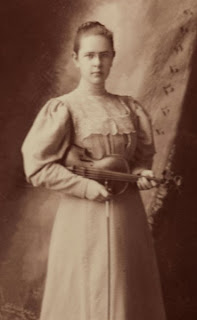On November 3rd and 4th,
the Borromeo String Quartet visited the Chicago area to perform two concerts. Of particular interest is the violin used by
Nicholas Kitchen, first violinist of the Quartet - an extraordinary Guarneri
del Gesu made in 1730 and known as the “Baron Vitta.” From 1929 until 1958, that instrument was
owned by Frances Glessner Lee. This
article will focus on that chapter in the long history of this celebrated
instrument.
Frances Glessner, c. 1896
As a teen, Frances “Fanny” Glessner played the
violin, as did her brother George. A
violin on display atop the piano in the parlor of the Glessner House Museum
recalls this fact. Although there is no
evidence she played in later years, music was always a central part of her
life, and she continued the extraordinary support of the Chicago Symphony
Orchestra that her parents began at the time of its founding in 1891.
The Baron Vitta in 1926
In early 1929, Frances Glessner Lee purchased
the Baron Vitta violin from the Rudolph Wurlitzer Company of New York, dealers
in rare old violins founded in 1856. She
paid $30,000 for the instrument and although the motivation that led to the
purchase is not documented, she immediately entered into an agreement to loan
it to Remo Bolognini, assistant concertmaster of the Chicago Symphony
Orchestra.
Remo Bolognini
Bolognini, born in Buenos Aires, Argentina in
1898, is generally regarded as South America’s greatest violinist. He began the study of the violin at the age
of seven, and his first recital six years later made him well known throughout
the continent. After performing for
three years with his brother Astor and Alberto Castellano at the Palace Theatre
in Buenos Aires, he accepted the position of concertmaster of the Philharmonic
Orchestra in that city. In 1927 he came
to the United States to assume the position of assistant concertmaster with the
Chicago Symphony Orchestra under Frederick Stock. After the conclusion of the 1928-1929 season,
he left the orchestra and traveled to Europe where he studied under the Belgian
violinist Eugene Ysaye and concertized extensively.
At one of those concerts he was heard by Arturo Toscanini, who engaged
him to be the second concertmaster with his orchestra, the NBC Symphony
Orchestra, formed in 1937. He remained
with that orchestra until 1954 when he became the assistant concertmaster with
the Baltimore Symphony. He died in 1977.
In 1939, Frances Glessner Lee requested that the
violin be returned to her, and after an unsuccessful attempt to sell the
instrument, she loaned it later that year to the Chicago Symphony Orchestra,
which gave it to their concertmaster, John Weicher, for his exclusive use. The violin attracted a great deal of
attention in the media, one article referring to it as “one of the most
valuable in the world.”
John Weicher with the Baron Vitta; Hans Lange (at left), assistant conductor, and
Frederick stock, conductor, look on, 1939.
John Weicher, Jr. was born in Chicago in 1904
and was the son of a violinist from Bohemia, who immigrated to Chicago in 1893. In 1912, the father took his eight-year-old son
to Prague where he spent four years studying at the conservatory. They were forced to return to Chicago in 1916
due to the World War and in 1919, Weicher joined the Chicago Civic Orchestra,
the CSO training orchestra, during its inaugural season. During the 1920s he played with the Cleveland
and Seattle orchestras and returned to Europe for further studies. In 1929, he took over for Bolognini as
assistant concertmaster with the Chicago Symphony Orchestra, and was elevated
to concertmaster in 1937. He remained in
that position for 23 seasons, 1937-1959 and again in 1962-1963, serving as
principal second violin from 1959-1962 and again from 1963-1969. He died in July 1969 at the age of 65.
John Weicher attempting to "pawn" the Baron Vitta
An amusing anecdote in the history of the
instrument took place in March 1940, when John Weicher attempted to pawn the
instrument to several pawnbrokers in Chicago.
Weicher bet that pawnbrokers would recognize the violin was of great
value; his friend Pence James, a reporter with the Chicago Daily News, said no. Weicher took the violin to four pawn shops
asking for a $100 loan, but three of the four didn’t recognize its value, one
pawnbroker stating “A hundred dollars? I can’t give you that kind of money for
a fiddle like this.” The fourth
pawnbroker did recognize that the violin had great value, but was suspicious of
the whole transaction, thinking it was a gag.
An article about the incident was published in the Chicago Daily News on
March 6, 1940.
Szymon Goldberg
The violin was returned to Frances Glessner Lee
in 1949 at which time she consigned it for sale with Rembert Wurlitzer in New
York. The instrument was finally sold in
1958 to Szymon Goldberg for $15,000.
Goldberg (1909-1993) was a distinguished Polish-born American violinist
and conductor, and founder and long-time conductor of the Netherlands Chamber
Orchestra in Amsterdam. He taught at
Yale, Juilliard, the Curtis Institute and elsewhere and one of his young
students was Nicholas Kitchen, first violinist with the Borromeo String
Quartet, who now plays his teacher’s violin.
Nicholas Kitchen
For more information on Goldberg and Kitchen and their history with the
instrument, see the online article published November 5, 2013 by WFMT entitled “Music Outsourced Brings Wonders.” To hear
Kitchen’s 2009 performance of Bach on the instrument, click here.









No comments:
Post a Comment